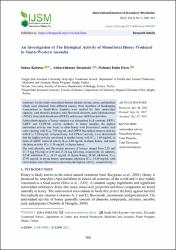An investigation of the biological activity of monofloral honey produced in south-western Anatolia
Citation
Karatas, S., A. Aktumsek, and M. E. Duru. 2021. "An Investigation of the Biological Activity of Monofloral Honey Produced in South-Western Anatolia." International Journal of Secondary Metabolite 8 (4): 300-311. doi:10.21448/ijsm.909460Abstract
In this study, monofloral honeys (chaste, thyme, citrus, and heather) which were obtained from different sources from members of Beekeeping Associations in South-West Anatolia were studied for their antioxidant capacity, total phenolic amounts, total flavonoid amounts, acetylcholinesterase (AChE), butyrylcholinesterase (BChE), and urease inhibition activities. Antioxidant capacity of honey samples was determined by β-carotene, DPPH, ABTS+ and CUPRAC activity methods. In honey samples, the highest antioxidant activity was found in citrus honey with β-carotene/Linoleic acid color opening with IC50: 7.99 mg/mL, and DPPH free radical removal activity with IC50: 5.28 mg/mL in thyme honey. In CUPRAC activity, it was determined that the highest activity was found in heather honey with IC50: 1.69 mg/mL, in terms of ABTS+ removal activity IC50: 2.80 mg/mL in chaste honey, and metal chelating activity IC50: 1.56 mg/mL in thyme honey. The total phenolic and flavonoids amounts of honeys ranged from 2.31 and 27.15 (μg PEs/mg) to 4.95 and 25.24 (μg QEs/mg), respectively. In addition, AChE inhibition IC50: 24.25 mg/mL in thyme honey, BChE inhibition IC50: 27.93 mg/mL in thyme honey, and urease inhibition IC50: 34.89 mg/mL with citrus honey were determined concerning the highest activity, consecutively. © 2021 International Journal of Secondary Metabolite.


















